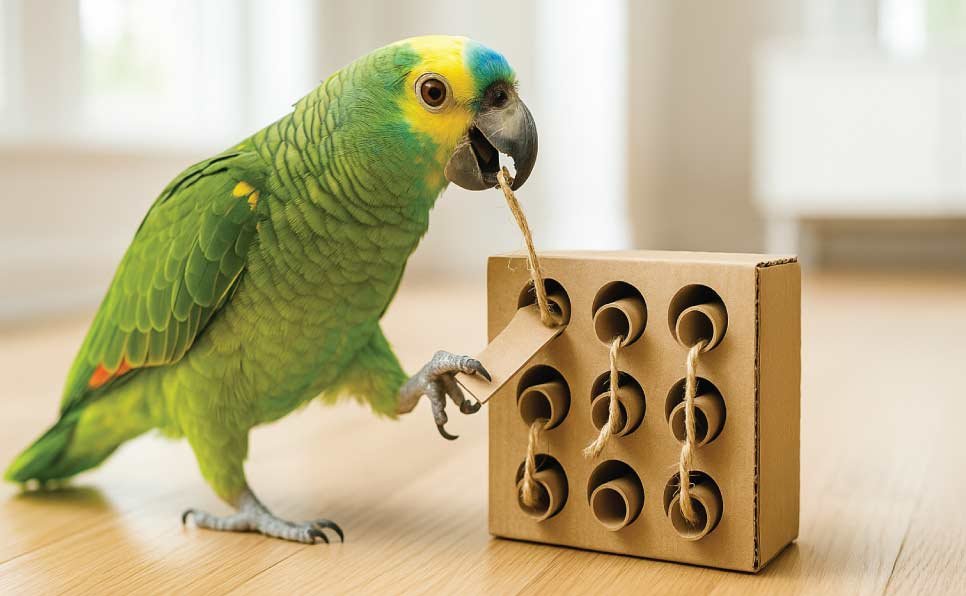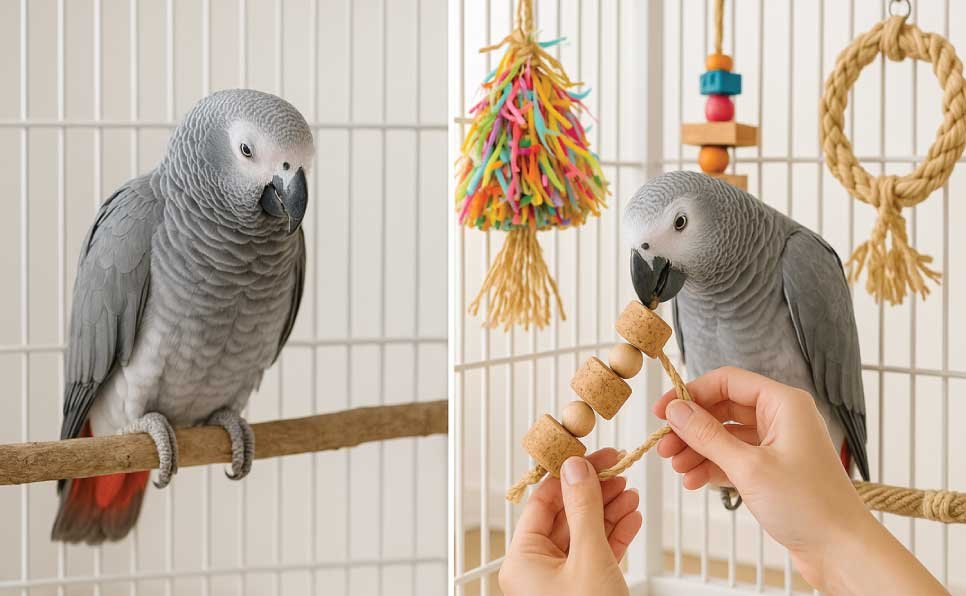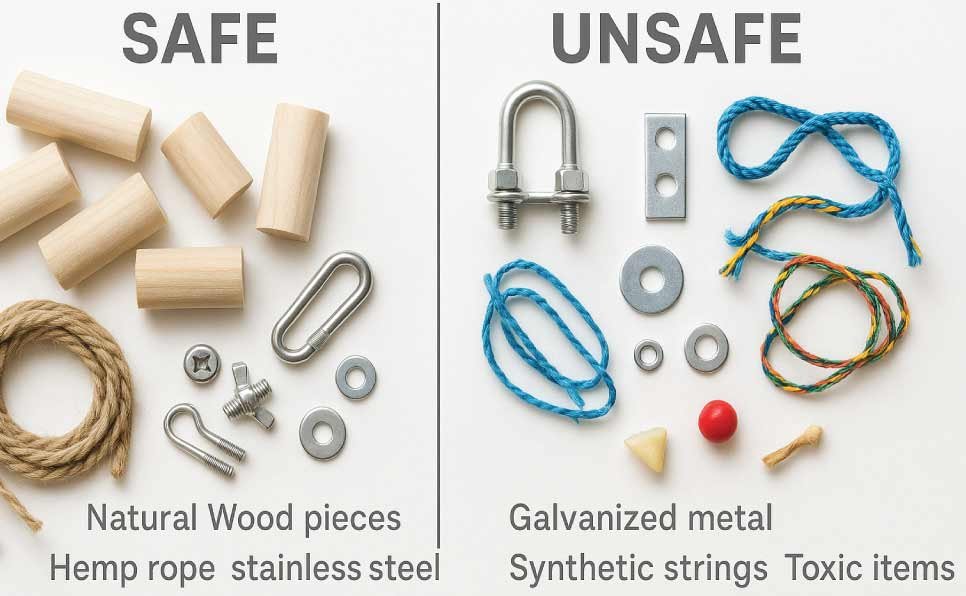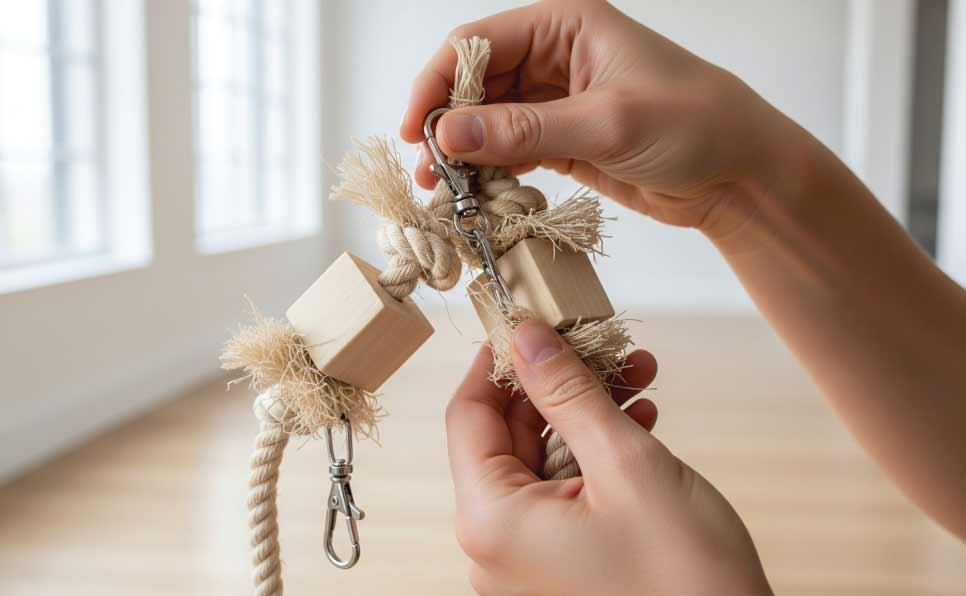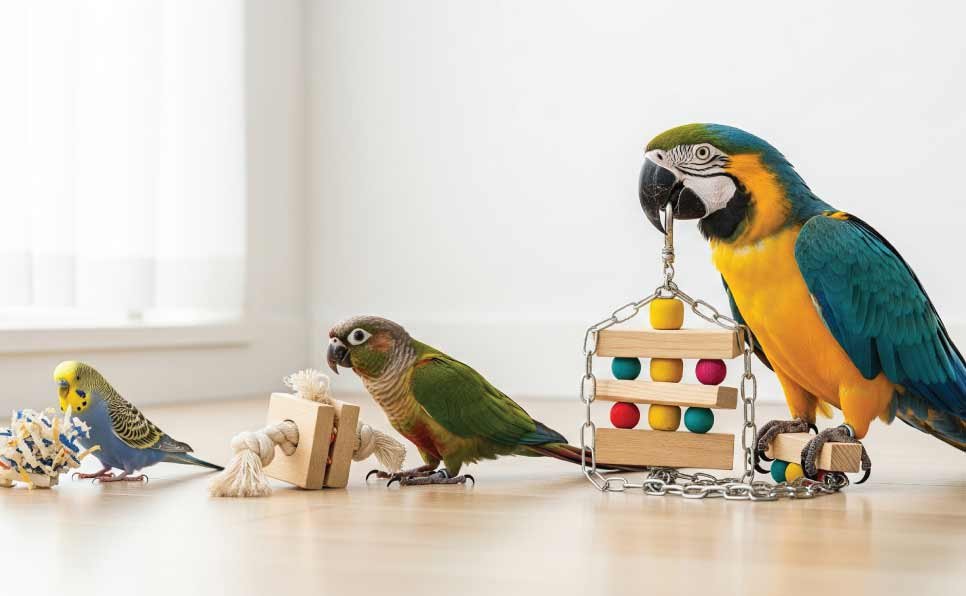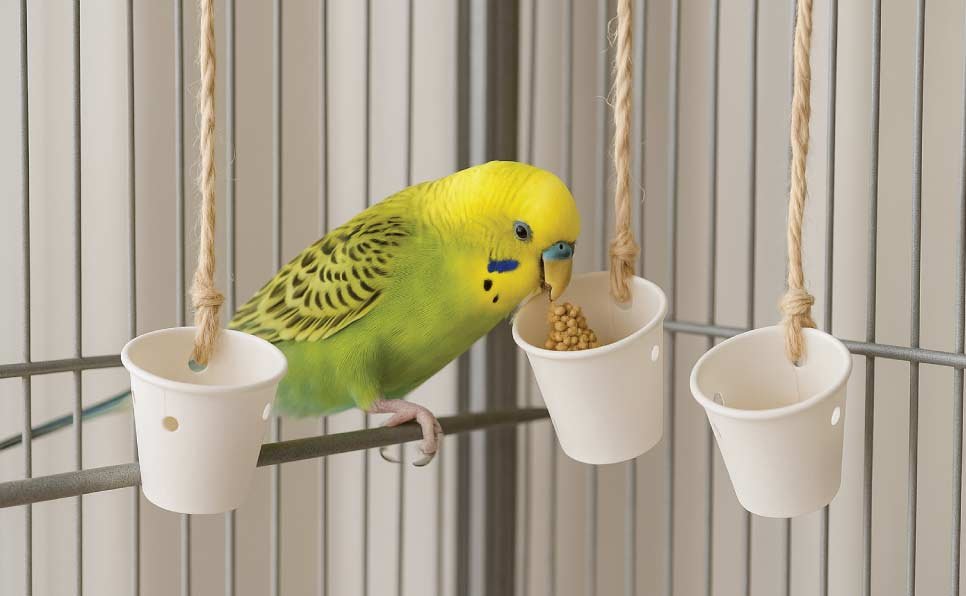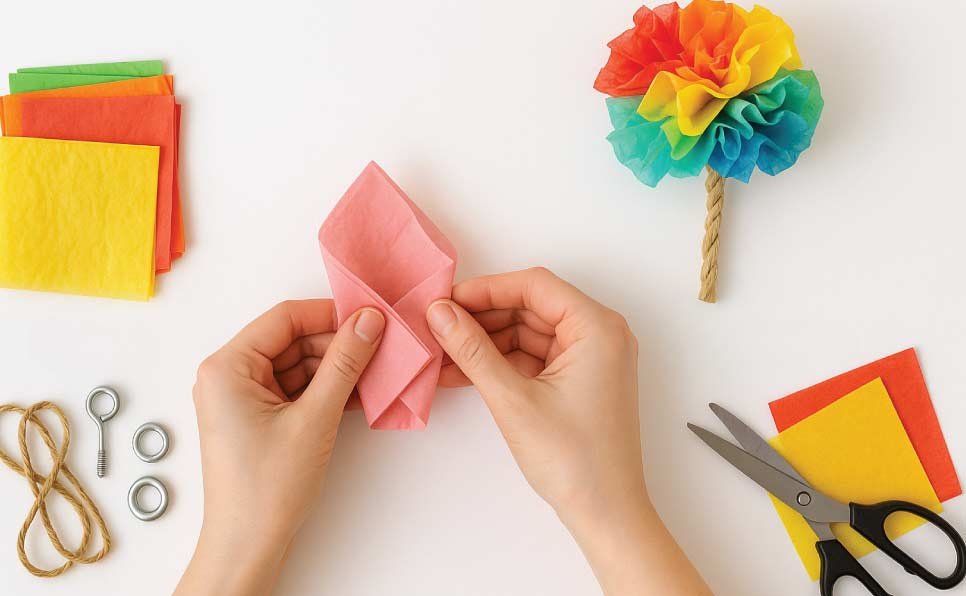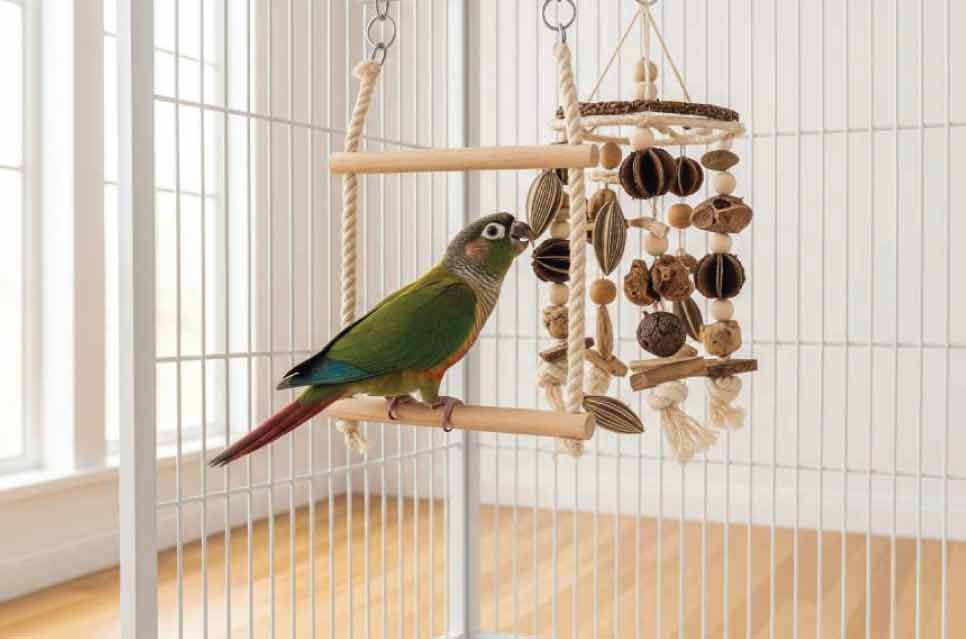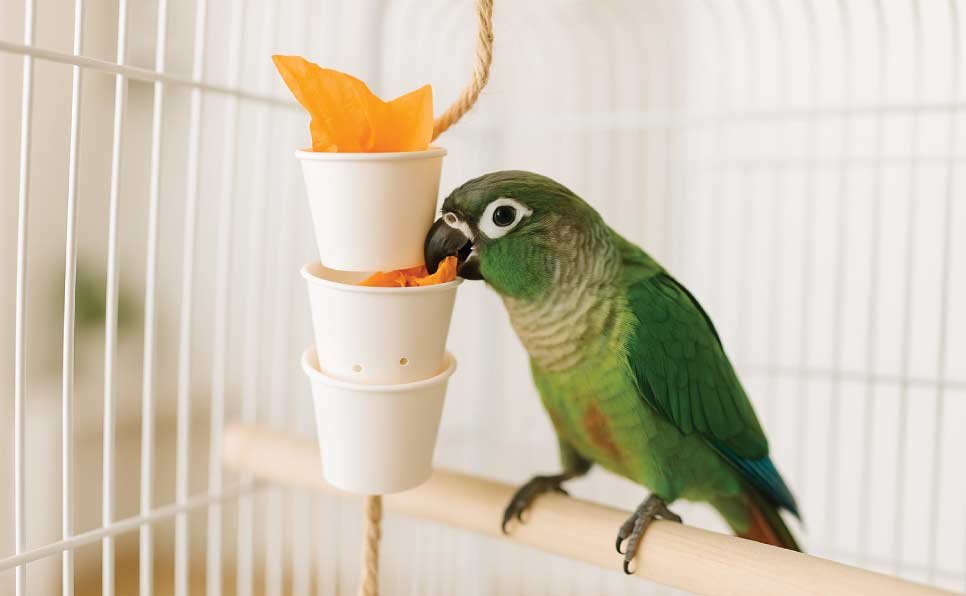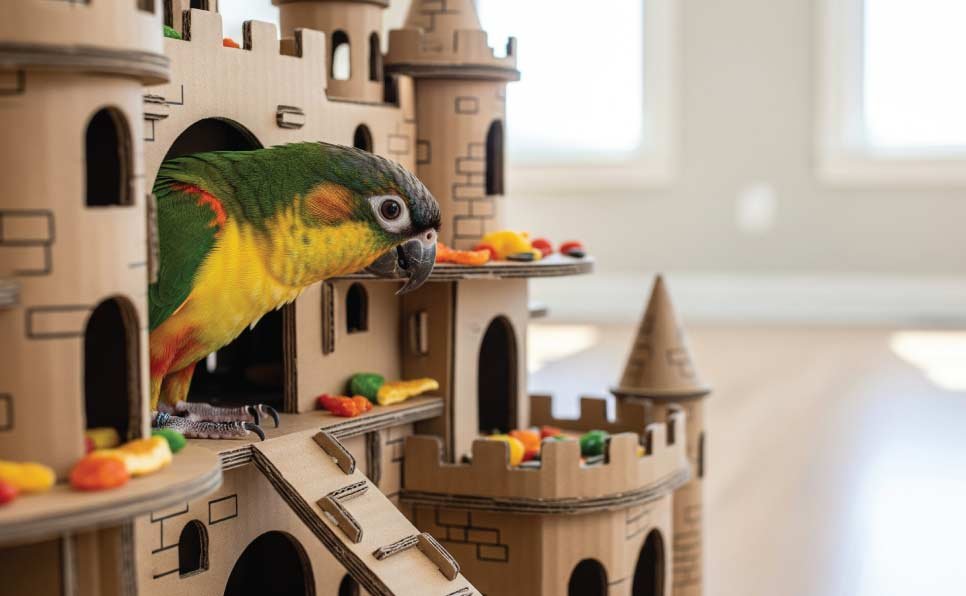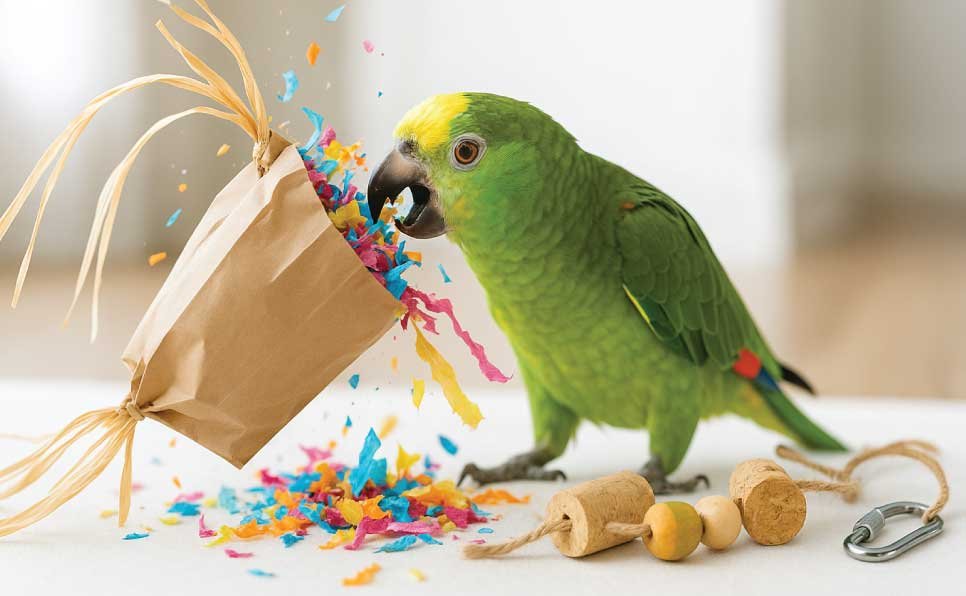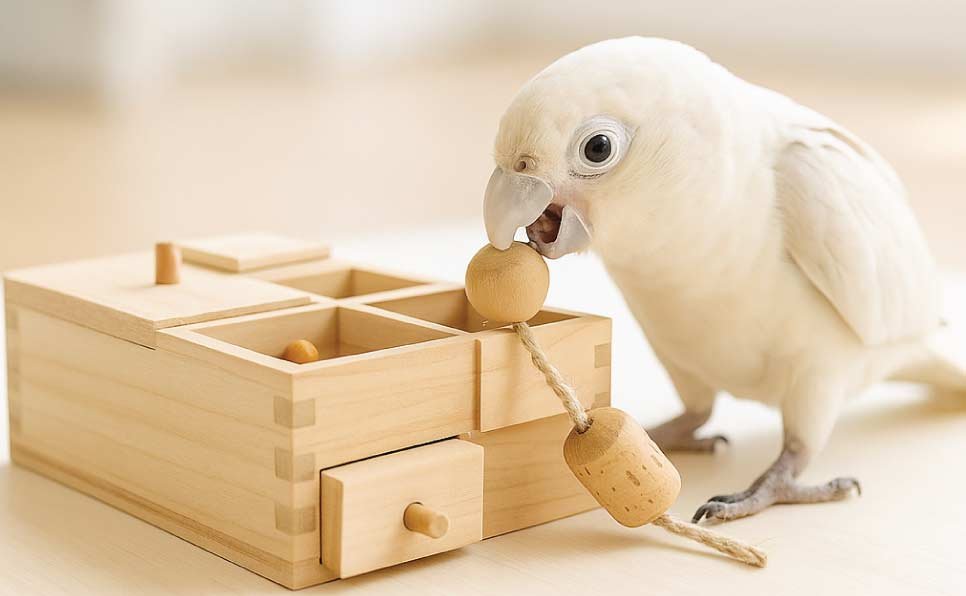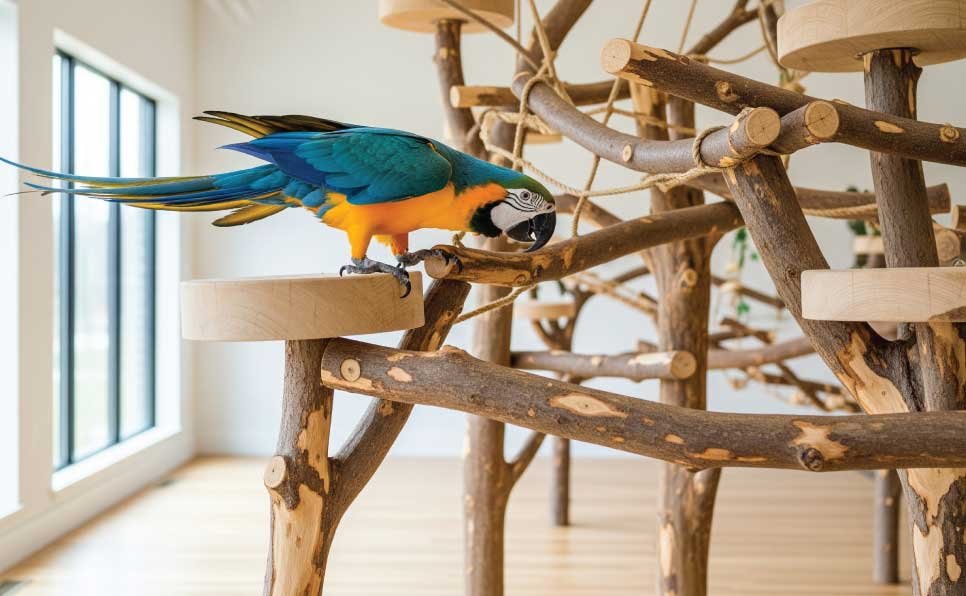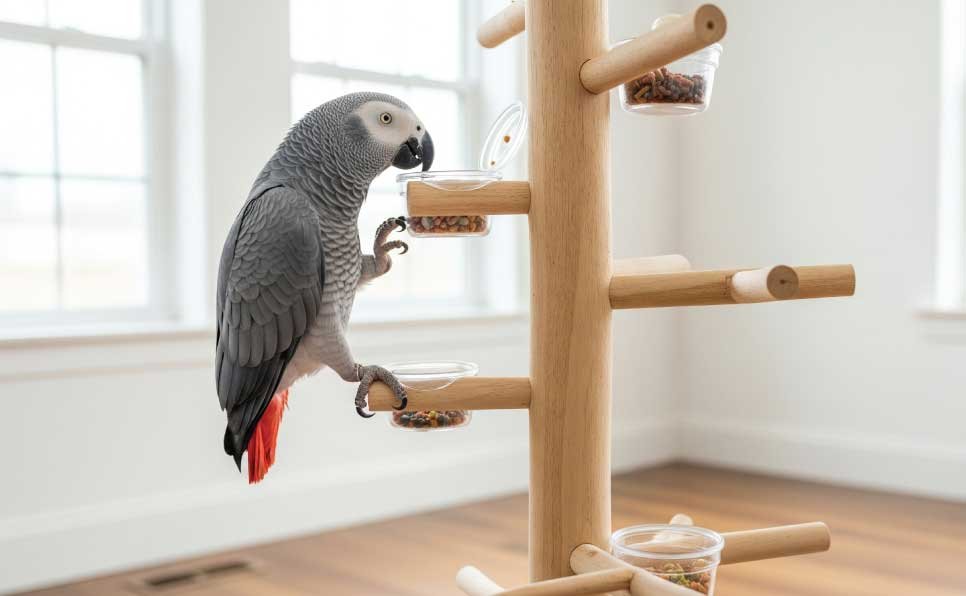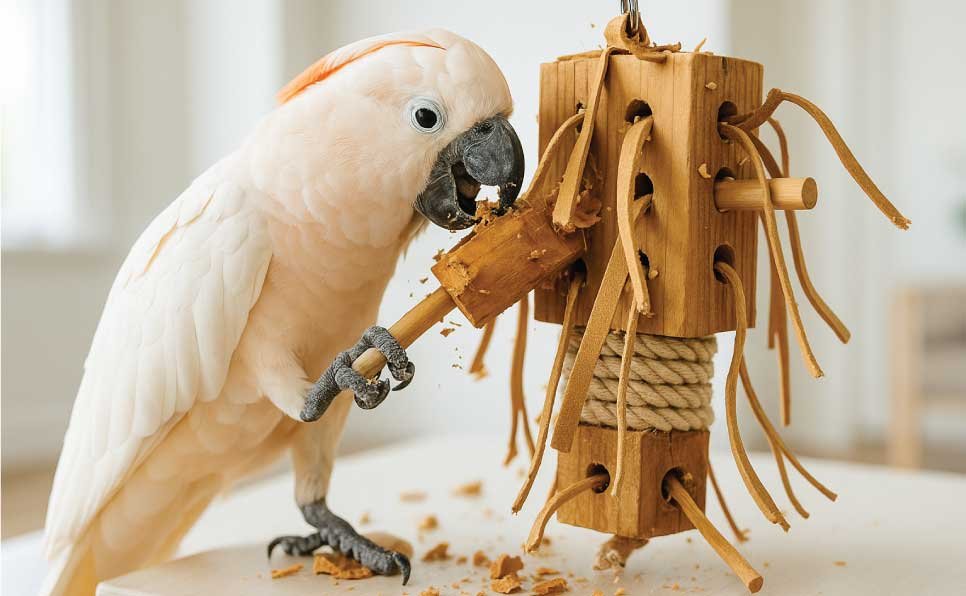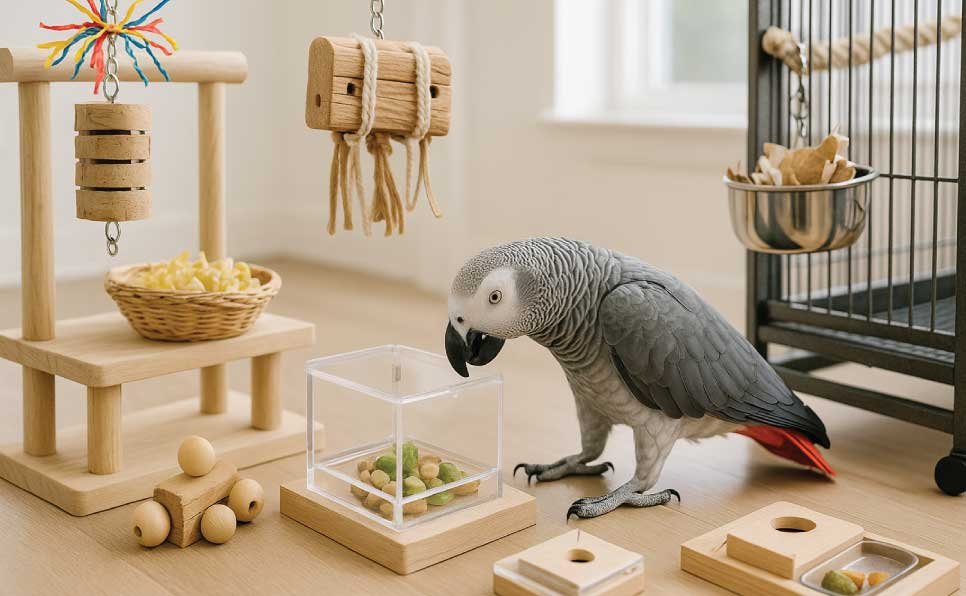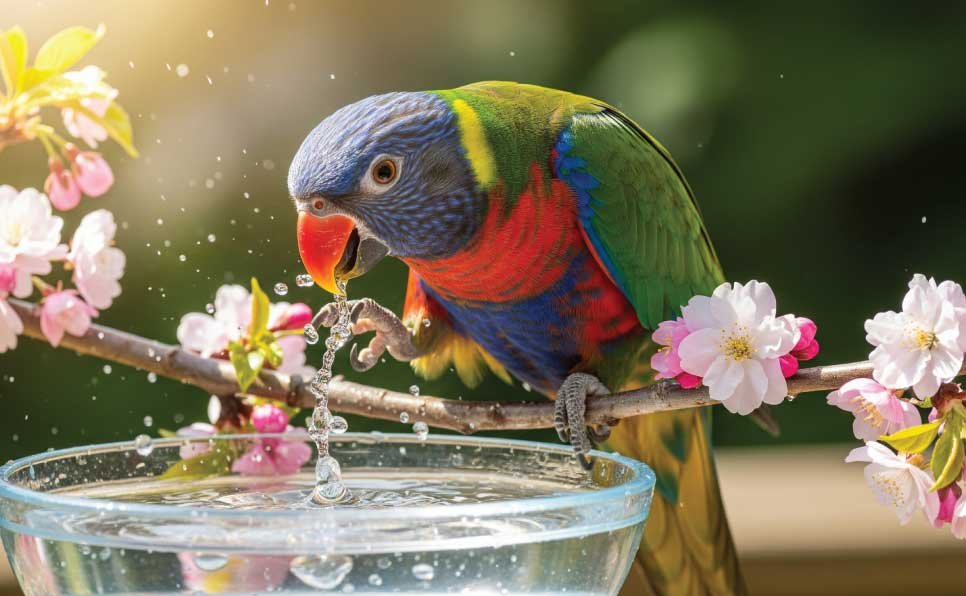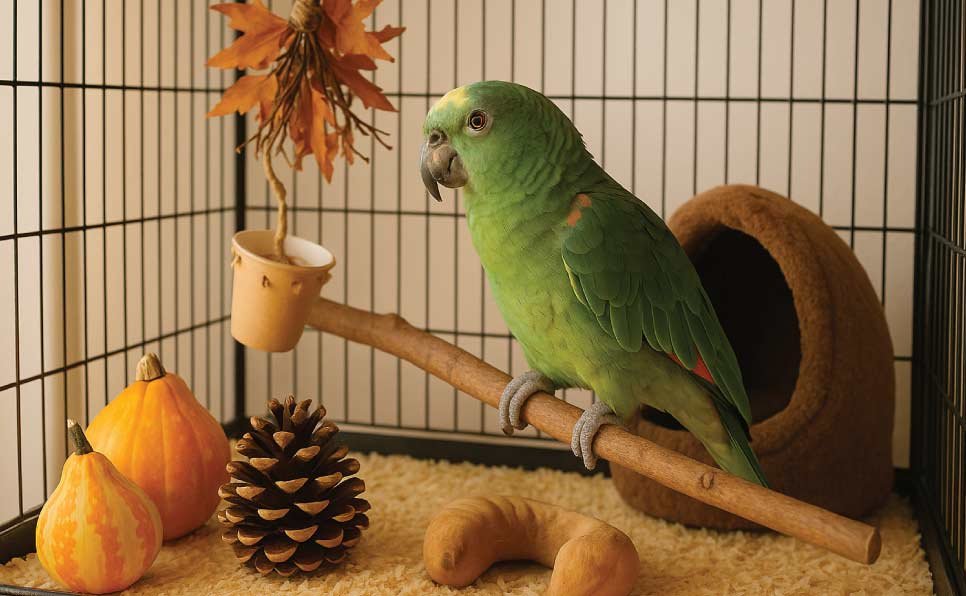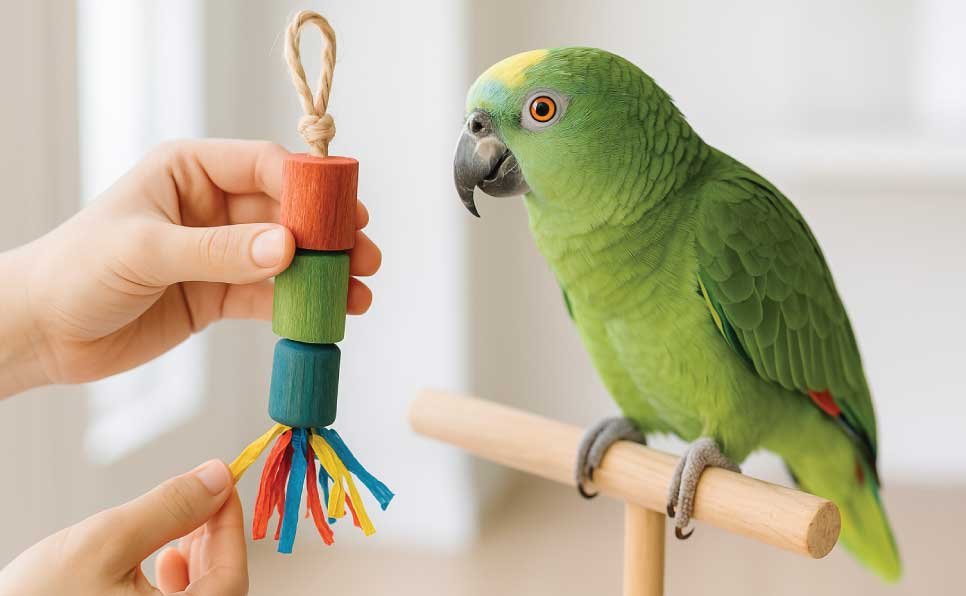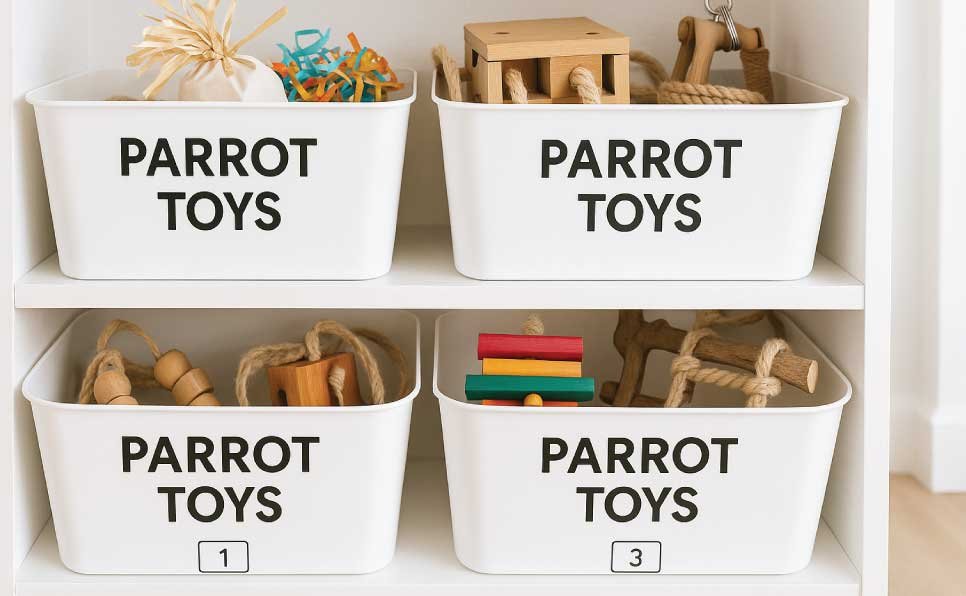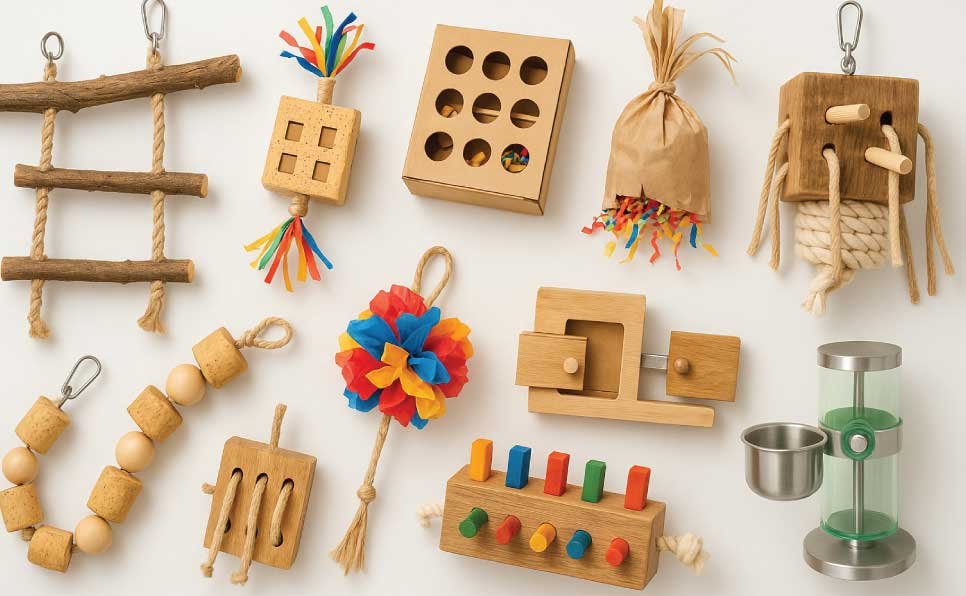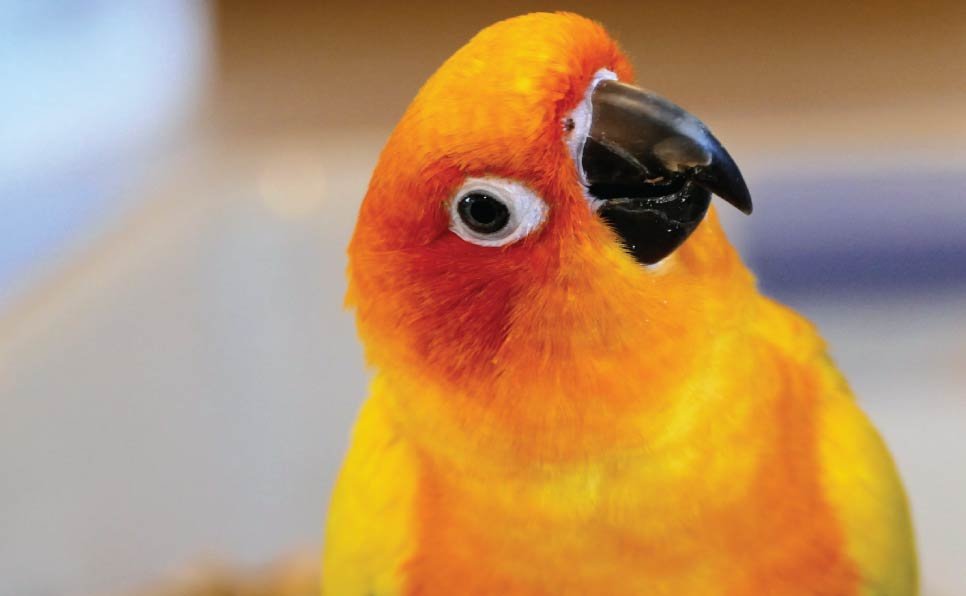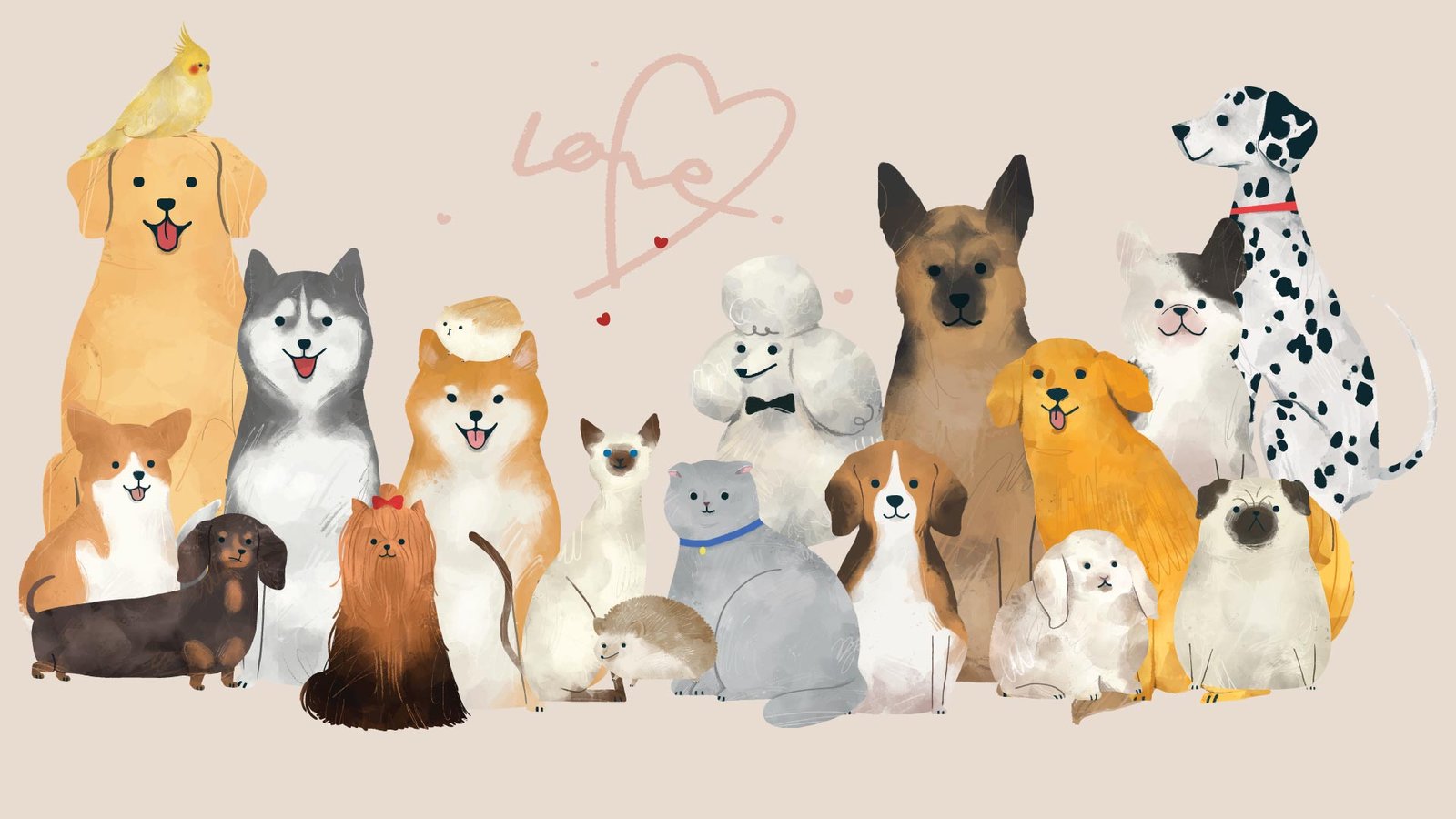At PetSweetJoy, we sometimes share products we truly love and use with our own pets. This post contains affiliate links, which means we may earn a small commission, at no extra cost to you. We only recommend products that fit our values of care, comfort, and responsible pet parenting.💗
Parrots are intelligent birds that need plenty of mental stimulation to stay active and healthy. DIY parrot toys can be a great way to provide your bird with both physical and mental enrichment. In this article I want to provide you with instructions for making a variety of DIY parrot toys, including cardboard cutouts, puff balls, paper shreds, bottle top foragers, bird braids, wrapped treats, and straw knots.
Did you know that parrots in the wild spend up to 80% of their waking hours foraging and exploring? If you’d like to recreate that same foraging challenge in your bird’s environment, the PVC Forager is a wonderful option. It’s a colorful, interactive toy with flip-up lids that hide treats like dried fruit or yogurt drops, encouraging your parrot to work for its food just like in the wild.
Yet many pet parrots live in environments where food appears magically in bowls, and entertainment is limited to a few store-bought toys. The result? Bored, stressed birds who develop behavioral problems like excessive screaming, feather plucking, and aggression.
Meet Charlie, an African Grey who spent his days pacing and screaming until his owner discovered the magic of DIY enrichment. Within weeks of introducing homemade puzzle toys and foraging challenges, Charlie transformed into a curious, engaged bird who whistled contentedly while solving his daily “problems.” The difference wasn’t expensive equipment, it was understanding what Charlie’s brilliant mind needed to thrive.
Listen to the Podcast: 20 DIY Toys for happy Parrots
Introduction
DIY parrot toys aren’t just cheaper than store-bought alternatives (though saving 70-80% on enrichment costs is nice). They’re infinitely customizable to your bird’s personality, interests, and changing needs. Plus, creating toys together strengthens the bond between you and your feathered companion in ways that simply buying toys never could.
In this guide, you’ll discover over 20 detailed DIY projects organized by parrot size, personality type, and skill level. Whether you’re dealing with a destructive cockatoo who demolishes everything in sight or a timid budgie who needs gentle encouragement to play, you’ll find exactly what you need to keep your parrot mentally stimulated, physically active, and genuinely happy.
- Parrots need a variety of toys to stay mentally stimulated and engaged.
- DIY parrot toys can be a fun and affordable way to provide your bird with enrichment.
- Be sure to use safe materials when making DIY parrot toys.
- Rotate your toys frequently to keep your bird interested.
Understanding Your Parrot's Play Needs
Not all parrots are created equal when it comes to play preferences. Understanding your bird’s personality is the key to creating toys they’ll actually use and enjoy, rather than ignore or fear.
If you’d like to learn more about the natural foraging behaviors that inspire many DIY toy designs, the Rhode Island Parrot Rescue’s guide on foraging for companion birds explains how enrichment activities mimic wild exploration and keep parrots mentally balanced.
Different Parrot Personalities & Toy Preferences
The Destroyer
These powerhouse parrots live to shred, tear, and demolish. Cockatoos, large conures, and many macaws fall into this category. They need heavy-duty toys that can withstand serious beak power and provide satisfying destruction. Think thick cardboard structures, natural wood branches, and leather strips. The goal isn’t to make toys that last forever, it’s to channel their destructive energy productively.
The Puzzle Solver
African Greys, Amazon parrots, and some cockatoos are natural problem-solvers who thrive on mental challenges. Birds that love solving problems will enjoy the Tilt-N-Treat Dispenser. This clever toy releases treats when your parrot rocks it back and forth, combining visual stimulation (thanks to its mirrored backing) with mental exercise that keeps clever birds entertained for hours.
They need toys with multiple steps, hidden compartments, and varying difficulty levels. A simple foraging cup won’t cut it, they want mechanical puzzles, sequential challenges, and toys that require genuine thinking to master.
The Acrobat
Many smaller parrots like cockatiels, conures, and caiques are natural athletes who love physical challenges. They prefer swings, climbing structures, and toys that encourage movement and coordination. These birds often enjoy toys that move and respond to their actions, creating dynamic play experiences.
To give your acrobatic parrots more climbing opportunities, the Flex Rope offers endless cage-mounted fun. Its flexible wire core lets you twist and bend it into ladders, bridges, or spirals, perfect for parrots who love swinging and balancing while they play.
The Gentle Player
Sensitive birds like some budgies, canaries, and recently rescued parrots need softer, quieter enrichment options. Loud, complex toys can be overwhelming. They prefer gentle textures, subtle movements, and toys that don’t demand immediate interaction but reward curiosity over time.
For shy or newly rescued birds, soft textures can make all the difference. The Boa Fleece Climber creates a gentle climbing surface that feels safe and cozy, offering both exercise and comfort without overwhelming sensitive parrots.
Signs Your Parrot Needs More Enrichment
Behavioral Red Flags:
- Excessive screaming, especially at predictable times
- Feather plucking or over-preening
- Aggression toward cage or family members
- Repetitive behaviors like head bobbing or pacing
- Lethargy or depression-like symptoms
- Destructive behavior directed at furniture or cage
Physical Signs:
- Overgrown nails from lack of natural wearing activities
- Poor muscle tone from insufficient climbing and exercise
- Stress bars on feathers indicating anxiety
- Changes in appetite or sleep patterns
Most parrots need 2-4 hours of active mental stimulation daily, plus additional environmental enrichment when they’re alone. If your bird shows signs of boredom, increasing enrichment should be your first intervention, often before considering behavioral modification or veterinary consultation for psychological issues.
Essential Safety Guidelines
Creating safe DIY toys is non-negotiable. One unsafe material can turn enrichment into an emergency veterinary visit. For more detailed veterinary advice on choosing safe and appropriate toys for your bird, you can explore VCA Animal Hospitals’ guide on Toys for Birds. It covers expert recommendations from avian veterinarians about toy types, safety standards, and how to introduce new enrichment items to different species.
Materials to NEVER Use
Toxic Metals:
- Galvanized hardware (zinc poisoning)
- Lead-based paints or weights
- Copper items (except pure, untreated copper)
- Nickel-plated items
Dangerous Strings and Fibers:
- Cotton string (can cause crop impaction)
- Synthetic threads that fray
- Rope longer than your bird’s body length
- Any string with loose ends longer than ½ inch
Toxic Woods and Plants:
- Avocado wood, leaves, or bark
- Cherry, peach, apricot wood (contains cyanide)
- Oak (high tannin content)
- Cedar or pine (aromatic oils irritate respiratory systems)
- Any wood treated with chemicals or stains
Unsafe Household Items:
- Toilet paper tubes (chemicals and glue)
- Newspapers with colored ink
- Styrofoam in any form
- Rubber or latex that can be swallowed
Small items under ¾ inch for large birds, ½ inch for small birds
Emergency Supply Kit
- Styptic powder for minor bleeding
- Clean towels for safe restraint
- Small flashlight for examination
- Transport carrier ready for use
- List of toxic materials and symptoms
Warning Signs Requiring Immediate Attention
- Difficulty breathing or open-mouth breathing
- Bleeding that doesn’t stop within 2-3 minutes
- Vomiting or regurgitation outside normal contexts
- Sudden behavior changes or loss of coordination
- Visible injuries or swollen areas
- Lethargy combined with other symptoms
Remember: When in doubt, contact your avian veterinarian immediately. Birds hide illness well, and rapid intervention can be life-saving.
Safe Material Checklist
Approved Woods:
- Apple, pear, or other fruit woods (pesticide-free)
- Birch, basswood, poplar
- Natural cork bark
- Bamboo (untreated)
- If you prefer to buy ready-made, bird-safe options instead of making your own perches, the Multi-Branch Perch is crafted from real wood and easily attaches to any cage. It gives parrots a sturdy, natural place to perch, swing, and exercise their feet safely.
Safe Ropes and Fibers:
- 100% natural sisal rope
- Untreated jute twine
- Hemp rope
- Natural raffia
- Coconut fiber
Paper Products:
- Unbleached coffee filters
- Plain white paper towels
- Computer paper (soy-based inks only)
- Cupcake liners (unbleached)
Hardware:
- Stainless steel (316 grade preferred)
- Nickel-plated brass quick links
- Vegetable-tanned leather
- Natural vine balls
Size Guidelines
Small Parrots (under 12 inches):
- Minimum safe object size: ¼ inch diameter
- Maximum rope length: 6 inches
- Toy weight limit: 2 ounces
Medium Parrots (12-20 inches):
- Minimum safe object size: ½ inch diameter
- Maximum rope length: 12 inches
- Toy weight limit: 8 ounces
- For medium-sized parrots that crave variety, the Jungle Canopy Toy Bundle combines three favorites: the Nap Nook, Corn Hammock, and PVC Forager, offering a balanced mix of comfort, climbing, and foraging in one playful set.
Large Parrots (over 20 inches):
- Minimum safe object size: ¾ inch diameter
- Maximum rope length: 18 inches
- Toy weight limit: 1 pound
Quality Control Checklist
Before introducing any DIY toy:
- Check all connections are secure
- Ensure no sharp edges or points
- Verify appropriate size for your bird
- Test that hanging toys won’t tangle
- Confirm all materials are bird-safe
- Remove or secure any loose threads
Weekly toy inspection:
- Look for wear, fraying, or damage
- Check hardware for loosening
- Replace worn components immediately
- Clean toys showing food residue or droppings
DIY Toys by Parrot Size
Small Parrots (Budgies, Cockatiels, Lovebirds)
Small parrots need delicate, appropriately-sized enrichment that won’t overwhelm their petite frames while still providing meaningful mental stimulation.
Mini Foraging Cups
Difficulty: Easy | Cost: $2 | Time: 10 minutes
Materials Needed:
- 6 small paper cups (3 oz bathroom cups work perfectly)
- Hole punch
- Natural sisal rope (¼ inch thick)
- Millet spray or small seeds
- Scissors
Step-by-Step Instructions:
- Punch holes around the rim of each cup, spacing them ½ inch apart
- Cut 6-inch lengths of sisal rope
- Thread rope through holes to create a hanging system
- Place a pinch of millet or seeds in each cup
- Hang at different heights in the cage
- Replace cups weekly or when destroyed
Why It Works: Creates multiple foraging opportunities while encouraging natural climbing behaviors. The paper cups are safely destructible, satisfying shredding instincts.
Tissue Paper Bouquet
Difficulty: Easy | Cost: $1 | Time: 5 minutes
Materials Needed:
- 8-10 pieces of colored tissue paper (bird-safe dyes only)
- Natural jute twine
- Scissors
Step-by-Step Instructions:
- Stack tissue paper pieces
- Accordion-fold the entire stack
- Secure center with jute twine
- Cut ends into rounded or pointed shapes
- Gently separate layers to create a full “bouquet”
- Attach to cage top or side
Why It Works: Provides satisfying shredding activity while creating interesting textures and sounds. The paper pieces float as birds interact with them, encouraging extended play.
Seed Pod Mobile
Difficulty: Medium | Cost: $5 | Time: 20 minutes
Materials Needed:
- 5-7 natural seed pods (sweet gum, lotus, or palm)
- Thin hemp rope
- Small wooden dowel (6 inches)
- Drill with small bit
Step-by-Step Instructions:
- Drill small holes through each seed pod
- Thread hemp rope through holes, leaving 2-inch tails
- Tie pods at varying lengths to the dowel
- Create a hanging loop at the dowel’s center
- Fill some pods with small seeds or treats
- Hang where pods can move freely
Why It Works: Combines foraging, manipulation, and movement. The natural materials are safe to chew, and the mobile aspect encourages physical activity.
Cork & Bead Chain
Difficulty: Easy | Cost: $3 | Time: 15 minutes
Materials Needed:
- 8-10 natural wine corks
- Large wooden beads (½ inch diameter)
- Hemp rope (¼ inch thick)
- Large needle or awl
Step-by-Step Instructions:
- Use needle to thread rope through corks lengthwise
- Alternate corks with wooden beads
- Keep total length under 8 inches
- Secure both ends with large knots
- Attach to cage with quick link
Why It Works: Perfect for beak exercise and manipulation. Corks provide satisfying texture for chewing, while beads add weight and interest.
Paper Cup Puzzle Feeder
Difficulty: Medium | Cost: $2 | Time: 15 minutes
Materials Needed:
- 3 graduated paper cups (3 oz, 5 oz, 7 oz)
- Skewer or sharp knife
- Small treats or pellets
- Tissue paper
Step-by-Step Instructions:
- Poke several ¼-inch holes in the smallest cup
- Place treats inside small cup
- Cover treats with tissue paper
- Nest small cup inside medium cup
- Place medium cup inside large cup
- Hang ensemble at foraging height
Why It Works: Creates a sequential puzzle requiring multiple steps to access treats. Builds problem-solving skills and extends feeding time naturally.
Medium Parrots (Conures, Caiques, Small Cockatoos)
Medium parrots need more robust toys that can withstand stronger beaks while providing greater physical and mental challenges.
Cardboard Castle Forager
Difficulty: Medium | Cost: $5 | Time: 30 minutes
Materials Needed:
- Large cardboard box (shoebox size)
- Smaller cardboard tubes and boxes
- Non-toxic glue stick
- Scissors or craft knife
- Various small treats
- Shredded paper
Step-by-Step Instructions:
- Cut multiple entrances in the large box (1-2 inches diameter)
- Create internal chambers using smaller boxes
- Cut connecting tunnels between chambers
- Hide treats in different chambers
- Fill some areas with shredded paper
- Secure lid with minimal glue (should be removable)
- Place on cage floor or secure to side
Why It Works: Encourages extended foraging behavior while providing hours of destructible fun. The multiple chambers create varying difficulty levels.
Rope & Wood Climbing Frame
Difficulty: Hard | Cost: $15 | Time: 45 minutes
Materials Needed:
- Natural branch (12-16 inches, 1-2 inches thick)
- Sisal rope (½ inch thick)
- 4-6 smaller perch branches
- Drill with various bits
- Stainless steel screws
- Quick links for hanging
Step-by-Step Instructions:
- Drill holes in main branch for smaller perches
- Insert and secure smaller branches at various angles
- Wrap intersections with sisal rope for grip
- Create rope “ladder” sections between some perches
- Add hanging elements from rope ends
- Install secure hanging points
- Attach to cage top with quick links
Why It Works: Provides essential physical exercise while mimicking natural tree environments. Multiple textures and levels encourage extended exploration.
Treat-Stuffed Piñata
Difficulty: Easy | Cost: $4 | Time: 20 minutes
Materials Needed:
- Large paper lunch bag
- Shredded paper (various colors)
- Favorite small treats
- Natural raffia or paper strips
- Hole punch
Step-by-Step Instructions:
- Fill bag 1/3 with shredded paper
- Add layer of treats
- Add more shredded paper
- Fold bag top and punch holes
- Thread raffia through holes to close and create hanger
- Add decorative raffia streamers
- Hang at appropriate height for destruction
Why It Works: Satisfies both foraging and destructive instincts. The layered construction creates multiple “rewards” as the bird works through it.
Bamboo Wind Chime
Difficulty: Medium | Cost: $8 | Time: 25 minutes
Materials Needed:
- 6-8 bamboo tubes (varying lengths, 4-8 inches)
- Natural wooden ring (3-4 inches diameter)
- Hemp rope
- Drill with small bit
- Sandpaper
Step-by-Step Instructions:
- Sand bamboo tubes smooth
- Drill holes near top of each tube
- Cut rope into varying lengths (6-12 inches)
- Thread rope through tubes and tie to wooden ring
- Vary hanging heights for different tones
- Add central hanging cord
- Test sound levels (should be gentle, not overwhelming)
Why It Works: Provides auditory enrichment while encouraging interaction. Natural materials are safe for chewing, and sounds stimulate curiosity.
Multi-Level Puzzle Box
Difficulty: Hard | Cost: $10 | Time: 60 minutes
Materials Needed:
- Wooden craft box with compartments
- Various lids (sliding, hinged, removable)
- Small wooden dowels
- Non-toxic wood stain (optional)
- Treats of different sizes
Step-by-Step Instructions:
- Modify compartments to require different opening methods
- Create sliding panels using dowels as tracks
- Add hinged lids to some compartments
- Make some lids require lifting or pulling
- Sand all edges smooth
- Apply bird-safe finish if desired
- Load with treats of increasing value by difficulty
Why It Works: Develops advanced problem-solving skills through sequential challenges. Can be reused indefinitely with different treat arrangements.
Large Parrots (Macaws, Large Cockatoos, African Greys)
Large parrots require substantial, challenging enrichment that can withstand powerful beaks while providing complex mental and physical stimulation.
Branch Playground System
Difficulty: Hard | Cost: $20 | Time: 90 minutes
Materials Needed:
- Main branch (24-30 inches, 2-3 inches thick)
- 6-8 secondary branches (various sizes)
- Thick sisal rope (¾ inch)
- Natural leather strips
- Stainless steel hardware
- Power drill with various bits
Step-by-Step Instructions:
- Select pesticide-free hardwood branches
- Scrub and sanitize all wood
- Plan layout for maximum climbing variety
- Drill connection holes and secure branches
- Add rope bridges between distant sections
- Incorporate leather hanging elements
- Create multiple attachment points for hanging toys
- Test all connections for security
- Install in cage with proper clearance
Why It Works: Mimics natural forest canopy structure while providing extensive physical exercise. Multiple textures and levels encourage natural behaviors.
Mega Foraging Tree
Difficulty: Hard | Cost: $25 | Time: 120 minutes
Materials Needed:
- Vertical wooden post (3 feet tall, 3 inches diameter)
- Multiple wooden cups or containers
- Various natural hiding materials
- Drilling equipment
- Mounting hardware
- Diverse treat selection
Step-by-Step Instructions:
- Plan container placement at multiple heights
- Drill holes for secure container mounting
- Install containers at varying angles and heights
- Fill containers with different foraging challenges
- Add bark, paper, and natural hiding materials
- Create easy, medium, and difficult foraging levels
- Secure entire structure to cage or floor stand
- Stock with high-value treats
Why It Works: Provides extended foraging opportunities that can occupy birds for hours. Varying difficulty levels prevent frustration while building skills.
Leather & Wood Destructor
Difficulty: Medium | Cost: $12 | Time: 45 minutes
Materials Needed:
- Large wooden block (4x4x6 inches)
- Vegetable-tanned leather strips
- Natural cotton rope (thick)
- Drill with large bits
- Wooden dowels
- Safe wood stain (optional)
Step-by-Step Instructions:
- Drill multiple holes of varying sizes through wooden block
- Thread leather strips through holes
- Add wooden dowels as “prey” to pull out
- Wrap sections with cotton rope
- Create hanging elements from leather strips
- Hide treats within the structure
- Secure hanging hardware
Why It Works: Satisfies strong destructive urges while providing substantial challenge. Natural materials are completely safe for consumption.
Interactive Puzzle Board
Difficulty: Hard | Cost: $18 | Time: 75 minutes
Materials Needed:
- Large wooden board (18×12 inches)
- Various lids, covers, and moving parts
- Hinges, slides, and rotating elements
- Multiple compartments
- Tools for precision work
Step-by-Step Instructions:
- Design board layout with multiple puzzle elements
- Create compartments requiring different solutions
- Install sliding panels, rotating discs, and lift-up sections
- Add sequential puzzles that build on each other
- Test all moving parts for smooth operation
- Sand and finish all surfaces
- Create treat-loading system for easy refilling
Why It Works: Develops advanced cognitive skills through complex mechanical puzzles. Reusable design provides long-term value.
Hanging Obstacle Course
Difficulty: Medium | Cost: $15 | Time: 60 minutes
Materials Needed:
- Multiple natural branches of varying thickness
- Thick rope for connections
- Wooden rings and platforms
- Chain or strong cable for main support
- Various textures (sisal, leather, natural fiber)
Step-by-Step Instructions:
- Plan course layout for progressive difficulty
- Create stable anchor points
- Connect elements with appropriate spacing
- Add varying textures and challenges
- Include rest platforms at intervals
- Test weight capacity thoroughly
- Install with proper safety clearances
Why It Works: Encourages extensive physical exercise while building coordination and confidence. Modular design allows for reconfiguration.
Specialized Enrichment Toys
Beyond basic size categories, some parrots need specialized enrichment targeting specific behaviors or skills.
Hidden Treasure Hunt System
Create a multi-location foraging experience by hiding treats in increasingly difficult locations throughout the day. Start with obvious spots and progress to complex puzzle solutions. This mimics the varied foraging challenges wild parrots face and can keep intelligent birds engaged for hours.
Rotating Puzzle Wheel
Construct a wheel with multiple compartments that can be rotated to reveal different foraging challenges. As birds master one configuration, rotate to present new puzzles. This single toy can provide weeks of varied enrichment.
Secret Compartment Box
Build a box with hidden compartments that open through different mechanisms, sliding panels, pressure points, rotating sections. This challenges spatial reasoning and mechanical understanding while providing substantial rewards for success.
Physical Activity Toys
Rope Gym Complex
Create an extensive climbing structure using various rope thicknesses, textures, and configurations. Include horizontal elements for strength building and vertical challenges for coordination development.
Swing Combinations
Combine multiple swing types, horizontal perches, vertical hang ropes, and spinning elements, to create dynamic movement opportunities that build core strength and balance.
Balance Beam Challenge
Install narrow perches at various heights and angles to encourage careful navigation and balance development. Add obstacles or toys along the beams for additional challenges.
Mental Stimulation Toys
Color Sorting Game
Create a system where birds must sort colored objects into matching containers to access treats. This develops visual discrimination and understanding of categories.
Mirror Maze
Construct a safe mirror maze that encourages problem-solving and spatial reasoning. Use unbreakable acrylic mirrors and ensure no small pieces can be removed.
Sound Recognition Box
Build a toy that responds to specific sounds or actions with treat rewards. This can help develop cause-and-effect understanding and auditory processing skills.
Seasonal & Holiday Themed Toys
Seasonal enrichment keeps your parrot’s environment fresh and exciting throughout the year while introducing natural variety.
To refresh your bird’s setup throughout the year, the Rainbow Accessory Bundle includes bright, engaging cage accessories such as the Jungle Gym, Corn Hammock, and Bungie Spring. It’s an easy way to rotate enrichment items and keep your parrot’s environment exciting every season.
Spring Enrichment (March-May)
- Nesting Material Dispensers: Fill containers with safe nesting materials like paper strips, natural fibers, and soft leaves. Even non-breeding birds enjoy manipulating these materials.
- Fresh Branch Rotations: Introduce pesticide-free flowering branches (apple, pear) for both foraging and chewing opportunities.
- Garden Box Foragers: Create shallow boxes filled with clean soil and buried treats, mimicking ground foraging opportunities.
Summer Enrichment (June-August)
- Water Play Stations: Set up shallow dishes with floating toys and treats for supervised splashing and foraging.
- Ice Treat Dispensers: Freeze fruits and vegetables in ice blocks for cooling enrichment during hot weather.
- Outdoor Exploration Toys: For supervised outdoor time, create portable foraging stations and climbing structures.
Fall Enrichment (September-November)
- Harvest Themed Foraging: Use natural gourds, corn husks, and seed pods filled with treats.
- Leaf Pile Foraging: Create safe “leaf piles” using dried, pesticide-free leaves with hidden treats.
- Acorn and Nut Puzzles: Use empty acorn shells and nut hulls as natural treat containers.
Winter Enrichment (December-February)
- Cozy Hideaways: Create warm, enclosed spaces using natural materials for comfort during shorter days.
- Warming Perches: Install heated perches or add extra-thick natural perches for comfort.
- Extended Indoor Foraging: Create more complex foraging systems to compensate for reduced outdoor stimulation.
Safe Holiday Decorations: Include bird-safe holiday elements like natural pine cones, apple garlands, and paper decorations.
Troubleshooting Common Issues
Even the best-planned enrichment programs can face challenges. Here’s how to address the most common problems parrot owners encounter.
“My Parrot Ignores New Toys”
Problem: Bird shows no interest in carefully crafted toys, leaving them untouched.
Solutions:
- Gradual Introduction: Place new toys outside the cage where birds can observe safely for several days before moving them inside.
- Model Interest: Show enthusiasm for the toy yourself. Play with it, hide treats in it, and demonstrate its use.
- Strategic Placement: Position new toys near favorite perches or feeding areas where birds spend time naturally.
- Food Motivation: Always include high-value treats in or near new toys to create positive associations.
- Size Adjustment: Ensure toys aren’t too large or overwhelming. Start smaller and gradually increase complexity.
- Familiar Scents: Rub toys with favorite foods or treats to add appealing scents.
“Toys Don’t Last Long Enough”
Problem: Bird destroys toys too quickly, making enrichment expensive and time-consuming.
Solutions:
- Embrace Destruction: Remember that destroying toys is natural and healthy behavior. Focus on providing appropriate destructible materials rather than trying to prevent destruction.
- Strategic Construction: Build toys with replaceable components. Create bases that last with interchangeable destructible elements.
- Graduated Materials: Use softer materials for initial engagement, progressing to harder materials that take longer to destroy.
- Rotation Strategy: Provide multiple toys but only present 2-3 at a time. Rotate regularly to extend interest.
- Batch Production: Make several similar toys at once to reduce individual construction time.
- Cost-Effective Materials: Focus on inexpensive, natural materials that can be replaced cheaply.
“My Bird is Afraid of New Toys”
Problem: Bird shows fear responses to new enrichment, fluffing, retreating, or vocalizing distress.
Solutions:
- Distance Introduction: Start with toys placed far from the cage, gradually moving closer over days or weeks.
- Familiar Materials: Use materials similar to toys the bird already accepts. Gradually introduce new textures and colors.
- Size Considerations: Ensure new toys aren’t larger than toys the bird already enjoys.
- Positive Associations: Always pair new toy introductions with favorite activities like mealtime or play sessions.
- Patience: Allow fearful birds weeks or even months to accept new enrichment. Never force interactions.
- Professional Support: Consider consulting an avian behaviorist for birds with extreme neophobia (fear of new things).
Toy Rotation & Maintenance System
A systematic approach to toy management ensures consistent enrichment while maintaining safety and cost-effectiveness.
Weekly Rotation Schedule Template
- Monday: Introduce one new toy, remove one familiar toy
- Tuesday: Check all toys for damage, clean soiled items
- Wednesday: Rotate foraging toys, add fresh treats to puzzle feeders
- Thursday: Switch physical activity toys (swings, climbing structures)
- Friday: Deep clean toys requiring sanitization
- Saturday: Prepare new toys for next week’s rotation
- Sunday: Assess bird’s preferences and plan upcoming enrichment
Cleaning & Sanitizing Process
- Daily: Remove food debris and droppings from toys
- Weekly: Wash toys with warm soapy water, rinse thoroughly
- Monthly: Disinfect with bird-safe sanitizer (diluted bleach solution: 1:10 ratio)
- As Needed: Replace worn or damaged components immediately
- Drying: Always air-dry completely before returning toys to birds. Moisture can harbor harmful bacteria and mold.
Storage Solutions
- Active Toys: Keep currently unused toys in clean, dry containers with tight-fitting lids
- Toy Components: Organize materials by type in clear containers for easy identification
- Seasonal Items: Store seasonal toys in labeled bins for annual rotation
- Backup Supplies: Maintain stock of commonly used materials for quick replacements
Lifespan Tracking
- Immediate Replacement: Toys showing sharp edges, loose small parts, or significant wear
- Weekly Assessment: Document which toys receive heavy use vs. those ignored
- Monthly Review: Evaluate overall enrichment effectiveness and plan improvements
- Seasonal Updates: Refresh entire toy collection quarterly to maintain novelty
Advanced Tips for Experienced Toy Makers
Once you’ve mastered basic DIY enrichment, these advanced techniques will take your parrot’s environment to the next level.
Batch Making Strategies
- Material Preparation: Cut rope, drill holes, and prepare components for multiple toys simultaneously
- Assembly Line Approach: Complete one construction step across multiple toys before moving to the next step
- Template Systems: Create reusable templates for commonly made toys to speed production
- Bulk Purchasing: Buy materials in larger quantities to reduce per-toy costs
Customization for Individual Birds
- Behavioral Observation: Document your bird’s play preferences, favorite materials, and typical play duration
- Difficulty Progression: Create toy versions of increasing complexity as your bird masters simpler challenges
- Sensory Preferences: Note preferences for textures, sounds, colors, and movements
- Physical Considerations: Adjust toy size, weight, and placement based on your bird’s physical capabilities and limitations
Community Resources
- Material Exchanges: Connect with other parrot owners to share bulk material purchases
- Design Sharing: Document successful toy designs and share with parrot communities online
- Skill Trading: Exchange toy-making services with other crafty parrot owners
- Group Projects: Organize community building sessions for complex enrichment projects
Building a Parrot Toy Library
- Documentation System: Photograph successful toys before they’re destroyed for future recreation
- Recipe Cards: Maintain detailed instructions for toys your bird particularly enjoys
- Material Database: Track which suppliers provide the best bird-safe materials at reasonable prices
- Seasonal Planning: Plan toy themes and materials months in advance for special occasions
Budget-Friendly Alternatives
Effective parrot enrichment doesn’t require expensive materials. Here are strategies for creating engaging toys on any budget.
Free Materials from Your Home
- Paper Products: Newspaper (black ink only), paper towels, coffee filters, paper lunch bags
- Cardboard: Shipping boxes, toilet paper tubes, cereal boxes (remove plastic liners)
- Natural Items: Pine cones (pesticide-free), fallen branches (safe species only), leaves
- Kitchen Items: Empty yogurt containers, ice cube trays, paper cupcake liners
Bulk Buying Strategies
- Rope and Cordage: Buy 100-foot spools rather than pre-cut lengths
- Hardware: Purchase stainless steel components in bulk from marine supply stores
- Wood Products: Contact local woodworkers for scrap pieces of safe wood species
- Paper Goods: Buy restaurant-supply quantities of plain paper products
Repurposing Household Items
- Plastic Containers: Use as foraging cups and treat dispensers (ensure no small parts can be removed)
- Old Clothing: Natural fiber fabrics can become shredding materials (remove buttons, zippers)
- Packaging Materials: Clean cardboard inserts and paper padding make excellent destructible toys
- Garden Supplies: Natural jute and sisal rope from garden centers costs less than pet store versions
Monthly Budget Planning
- Basic Enrichment: $10-15/month provides adequate variety for most parrots
- Enhanced Program: $20-30/month supports complex, varied enrichment
- Premium Setup: $40-50/month allows for specialized materials and frequent rotation
- Cost Tracking: Monitor actual spending to optimize material choices and reduce waste
Interactive Resources
Printable Parrot Personality Quiz
Rate your parrot 1-5 on each behavior:
Destruction Level:
- Shreds paper aggressively (1-5)
- Gently nibbles materials (1-5)
Problem-Solving Interest:
- Solves complex puzzles quickly (1-5)
- Prefers simple, obvious challenges (1-5)
Physical Activity:
- Constantly climbing and swinging (1-5)
- Prefers stationary activities (1-5)
Sound Tolerance:
- Enjoys noisy, interactive toys (1-5)
- Startled by loud or sudden sounds (1-5)
Social Play:
- Prefers toys when owners are nearby (1-5)
- Plays independently (1-5)
Scoring:
- 36-50 points: High-intensity enrichment needed
- 21-35 points: Moderate challenges with variety
- 15-20 points: Gentle, gradual enrichment
10-14 points: Simple, non-threatening toys
DIY Parrot Toys: Frequently Asked Questions (FAQs)
While DIY parrot toys offer room for creativity, it's essential to stick to safe materials. Avoid small, sharp, or toxic items. Opt for bird-friendly materials like wood, cardboard, and natural fibers.
Rotate your parrot's toys regularly to keep them interested and prevent boredom. This helps stimulate their minds and prevents them from losing interest in the same toys over time.
Yes, safety is crucial. Ensure the toy is securely attached to the cage or perch to prevent accidents. Always supervise play to avoid any small parts being swallowed, and regularly inspect toys for wear and tear.
Watch for signs of engagement, like enthusiastic play, exploration, and vocalization. Pay attention to your parrot's preferences for certain textures and materials, and tailor future DIY toys to their liking for maximum enjoyment.
If you think your parrot has swallowed a part of a toy, monitor them closely for any signs of distress or discomfort. If you are concerned, take them to the veterinarian immediately.
Not all parrots will be interested in every toy you make for them. Experiment with different materials, textures, and shapes to find what your parrot enjoys. You can also try adding treats or other enrichment items to the toys to make them more appealing.
You can start introducing DIY toys to your parrot as soon as they are out of their nest and beginning to explore their environment. However, it is important to supervise them closely at first to make sure they are not chewing on any small or dangerous parts.
Conclusion
In the vibrant world of our feathered companions, mental stimulation is the key to a happy and healthy parrot.
Making toys for your parrot is really special. It’s not just about giving them something to do. It shows you care about how smart they are and what they like to do naturally. It also helps you become closer friends. When you make toys with your own hands, your parrot can feel how much you love them. This is something you can’t get from toys you buy at the store.
When you start making simple cardboard toys and then learn to make harder puzzle toys, you learn more about what your parrot likes. You watch what makes them happy, what is fun for them, and what makes them curious. This helps you become a better parrot owner.
Remember that all birds are different. One parrot might love a toy that scares another parrot. A toy that is perfect for a young, brave bird might be too hard for an old or shy bird. The best part about making your own toys is that you can change them. You can make them easier or harder based on what your bird tells you they like.
If you’re just starting to make toys, begin with easy ones. Pick one or two simple projects that are right for your bird’s size. Watch how they play with them. A good toy doesn’t have to last a long time or be fancy. The best toy is one that makes your parrot happy and interested. Sometimes a simple paper cup with treats inside works better than a complicated toy your bird won’t touch.
Always keep your bird safe when making toys. If you’re not sure if something is safe, don’t use it. No toy is worth hurting your bird. Keep your bird doctor’s phone number where you can find it easily. Check toys often and throw away any that look broken or dangerous.
Remember, you don’t have to be perfect – you just need to try. Every new toy you make, every time your bird plays happily, and every problem you figure out together makes your friendship stronger. These amazing birds need us to take care of them. Making special toys just for them is one of the best ways to show we care.
The best part is watching your parrot. You’ll see them chattering happily when they find a new puzzle. You’ll watch them think hard as they try to get treats out of a toy. You’ll see them cleaning their feathers after a fun play time. These happy moments are why making DIY toys is so special. They show that you and your parrot really understand and care about each other.
Recommended Enrichment Tools
If you’d like to complement your DIY creations with a few safe, ready-made options, here are some of my favorite enrichment tools for parrots:
- 🧩 PVC Forager: Encourages natural foraging behavior.
- 🪞 Tilt-N-Treat Dispenser: Interactive puzzle for curious parrots.
- 🧗 Flex Rope: Bendable rope for climbing and acrobatics.
- 🪶 Boa Fleece Climber: Soft climbing toy for gentle players.
- 🌳 Multi-Branch Perch: Real-wood perch that supports natural foot exercise.
- 🌴 Jungle Canopy Toy Bundle : Combines multiple enrichment toys in one.
- 🌈 Rainbow Accessory Bundle: Seasonal accessory set to refresh cage setups.
All links above are affiliate links. I may earn a small commission at no extra cost to you. Thank you for supporting PetSweetJoy.com.

